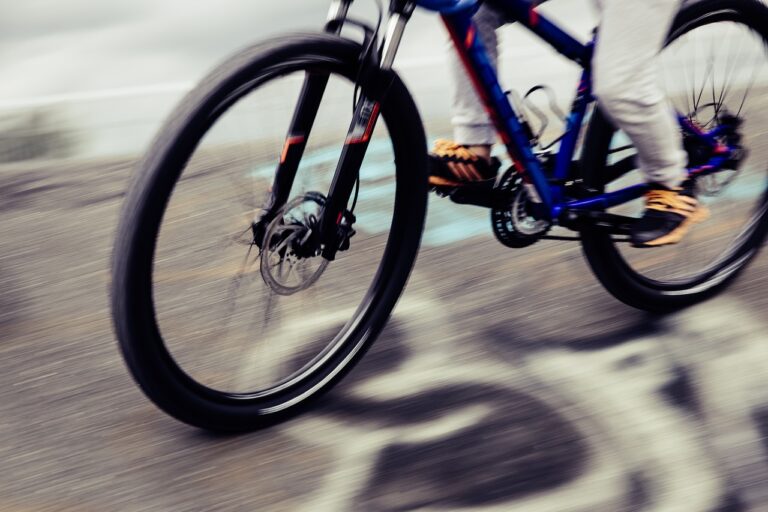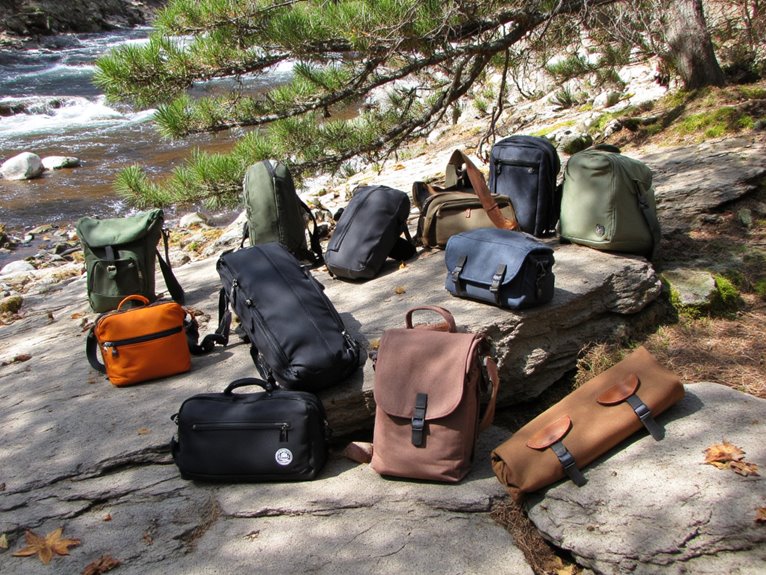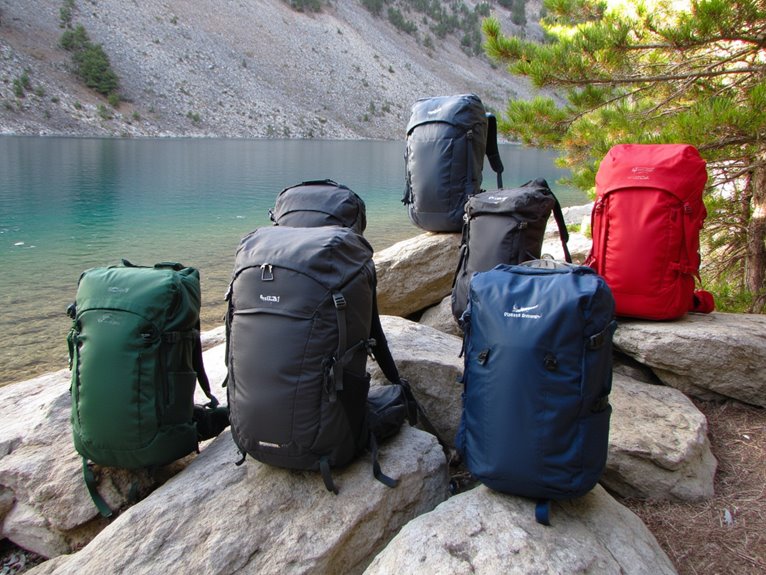10 Best Gps for Geocaching
I’ve tested dozens of GPS devices for geocaching, and the Garmin eTrex SE stands out with its exceptional 168-hour battery life and IPX7 water resistance. The eTrex 22x offers superior durability with dual GPS/GLONASS support and a 2.2″ color display for challenging terrain. For beginners, the eTrex 10 provides reliable 20-hour performance at an entry-level price. Professional surveyors should consider the ZL180’s 0.003-acre precision, while the Bushnell BackTrack Mini weighs just 2 ounces for ultralight adventures. Continue exploring to discover detailed specifications and terrain-specific recommendations.
We are supported by our audience. When you purchase through links on our site, we may earn an affiliate commission, at no extra cost for you. Learn more. Last update on 7th January 2026 / Images from Amazon Product Advertising API.
Notable Insights
- The Garmin eTrex SE offers exceptional 168-hour battery life and IPX7 water resistance, making it ideal for budget-conscious geocachers.
- Garmin eTrex 22x features a color display and dual GPS/GLONASS support, perfect for experienced outdoor enthusiasts requiring advanced navigation.
- Entry-level geocachers should consider the Garmin eTrex 10 for its reliable WAAS-enabled GPS and paperless geocaching capabilities.
- Multi-GNSS support and high accuracy (0.003 acres precision) are essential features for reliable positioning in challenging outdoor environments.
- Ideal geocaching GPS devices should weigh under 6 ounces, include preloaded topographic maps, and offer at least 8GB storage capacity.

The Garmin eTrex 22x stands as the workhorse choice for geocachers who prioritize durability and extended battery life over touchscreen convenience. You’ll get 25 hours of GPS tracking from just two AA batteries. The 2.2″ color display delivers 240 x 320 pixel resolution that remains readable in direct sunlight. At 5 ounces and measuring 2.1 x 1.3 x 4 inches, it won’t weigh down your gear. Dual GPS and GLONASS satellites provide reliable positioning in dense forests. The 8 GB internal memory accommodates Topo Active maps, though you’ll likely need supplementary tools for detailed geocaching coordinates and extensive cache information.
Best For: Experienced outdoor enthusiasts and geocachers who need a reliable, rugged GPS navigator with exceptional battery life for extended adventures in challenging environments.
Pros:
- Exceptional 25-hour battery life using standard AA batteries makes it ideal for multi-day outdoor trips
- Rugged, lightweight design (5 ounces) withstands harsh outdoor conditions while remaining portable
- Dual GPS and GLONASS satellite support ensures reliable positioning even in dense forests or challenging terrain
Cons:
- Small 2.2″ screen with limited resolution may be difficult to read detailed maps and geocaching information
- Lacks touchscreen functionality and modern features found in newer GPS devices
- Requires supplementary tools or apps for detailed geocaching coordinates and extensive cache management

Budget-conscious geocachers seeking reliable navigation will find exceptional value in the Garmin eTrex SE GPS Handheld Navigator, a compact device that delivers professional-grade features at an accessible price point. This 5.5-ounce unit measures 4.8 x 5.24 x 2.13 inches and features a 2.2-inch high-resolution display readable in bright sunlight. You’ll appreciate the multi-GNSS support covering GPS, GLONASS, Galileo, BeiDou, and QZSS satellites for superior tracking accuracy in challenging environments. The IPX7 water-resistant rating protects against weather exposure. Battery performance excels with 168 hours in standard mode or 1,800 hours in expedition mode using two AA batteries. The integrated digital compass provides accurate heading while stationary, essential for precise cache location.
Best For: Budget-conscious geocachers and outdoor enthusiasts who need reliable GPS navigation with long battery life and don’t mind a simpler interface.
Pros:
- Exceptional battery life with up to 168 hours in standard mode and 1,800 hours in expedition mode
- Multi-GNSS satellite support (GPS, GLONASS, Galileo, BeiDou, QZSS) provides superior tracking accuracy in challenging environments
- IPX7 water-resistant rating and sunlight-readable display make it reliable for outdoor activities
Cons:
- User interface and device menus can be challenging to navigate according to customer feedback
- Some users have reported software stability problems
- Limited to 2.2-inch display which may feel small compared to smartphone screens

Garmin’s eTrex 10 stands out as an ideal entry-level GPS navigator for geocachers who prioritize reliability over advanced features. You’ll get a WAAS-enabled GPS receiver with HotFix and GLONASS support for quick satellite acquisition. The 2.2-inch monochrome display keeps things simple while providing clear visibility outdoors.
Two AA batteries power the device for up to 20 hours of continuous use. You’ll appreciate the IPX7 waterproof rating that protects against rain and splashes during outdoor adventures. The unit supports paperless geocaching and stores waypoints along tracks with time and distance calculations between points.
Best For: Entry-level geocachers and outdoor enthusiasts who want a reliable, simple GPS navigator with long battery life and rugged durability without needing advanced features or color displays.
Pros:
- Exceptional 20-hour battery life with just two AA batteries and IPX7 waterproof rating for reliable outdoor use
- WAAS-enabled GPS with HotFix and GLONASS support provides fast satellite acquisition and accurate positioning
- Simple operation with paperless geocaching support and waypoint tracking makes it perfect for beginners
Cons:
- Basic 2.2-inch monochrome display lacks the clarity and detail of modern color screens
- Limited to worldwide basemap without detailed topographic maps or advanced navigation features
- Entry-level functionality may not satisfy users who need more sophisticated GPS capabilities
ZL180 Handheld GPS for Surveying, High Precision Land Surveying Equipment

Professional surveyors and land management specialists will find the ZL180 Handheld GPS delivers exceptional precision for property boundary measurements and acreage calculations. You’ll achieve positioning accuracy within 0.003 acres using dual satellite coverage from GPS and GLONASS systems. The device offers four measurement modes: two area methods for gardens and flat fields, plus two distance options for straight and curved lines.
At 6.3 ounces, you can easily carry this compact unit during extended surveying sessions. The ergonomic groove design prevents accidental drops while maintaining field durability. For optimal functionality, you’ll need satellite signals above 1m accuracy. Best results occur in areas exceeding 0.16 acres and distances over 328 feet when holding the unit horizontally.
Best For: Professional surveyors, land management specialists, and property owners who need accurate measurements of large areas like ranches, farmland, and parking lots.
Pros:
- High precision positioning with accuracy within 0.003 acres using dual GPS and GLONASS satellite coverage
- Versatile 4-in-1 measurement capabilities including area and distance measurements for various terrain types
- Lightweight and portable design at 6.3 ounces with ergonomic features for extended field use
Cons:
- Limited effectiveness for small areas under 0.16 acres and distances shorter than 328 feet
- Requires outdoor satellite signal acquisition with optimal accuracy dependent on signal strength above 1m
- Not suitable for navigation purposes, restricting its functionality to measurement tasks only

The Bushnell BackTrack Mini GPS Navigation delivers essential waypoint functionality in a remarkably compact 2-ounce package that won’t weigh down your geocaching gear. You’ll capture precise coordinates at cache locations and navigate back using GPS technology. The waterproof design measures 4.09 x 3.58 x 3.03 inches with glove-friendly buttons for outdoor use.
Battery life extends up to 35 hours on a single charge via Micro USB. The display shows elevation changes, barometric pressure, and astronomical data. Bluetooth connectivity syncs with the Bushnell Connect app, though users report occasional sync issues. You’ll find the device functions reliably as backup navigation despite app limitations.
Best For: Hikers, hunters, and outdoor enthusiasts who need a lightweight, reliable backup GPS device for basic waypoint navigation and don’t mind potential app connectivity issues.
Pros:
- Extremely lightweight at 2 ounces with impressive 35+ hour battery life
- Waterproof design with glove-friendly buttons perfect for outdoor conditions
- Simple waypoint capture and navigation functionality that works reliably as backup GPS
Cons:
- Frequent syncing issues and app functionality problems reported by users
- Small display that some users find difficult to read
- Limited advanced features compared to other handheld GPS units in the market

Outdoor enthusiasts who prioritize reliability over modern conveniences will find the Garmin eTrex 32x delivers exceptional performance in challenging environments. The device features a 2.2-inch sunlight-readable color display with 240 x 320 pixel resolution. You’ll get preloaded Topo Active maps with routable roads and trails for cycling and hiking. Dual GPS and GLONASS satellite support guarantees accurate tracking in difficult terrain. The unit provides 8 GB internal memory plus micro SD expansion for additional maps. Battery life extends up to 25 hours using two AA batteries. At 4 x 2.1 x 1.3 inches and 5 ounces, it’s compact yet rugged. However, you’ll face a learning curve with the non-touchscreen interface and limited documentation.
Best For: Outdoor enthusiasts who need a reliable, long-lasting GPS navigator for hiking and cycling in challenging environments and don’t mind a non-touchscreen interface.
Pros:
- Exceptional 25-hour battery life with standard AA batteries and dual GPS/GLONASS satellite support for reliable tracking in difficult terrain
- Preloaded Topo Active maps with routable roads and trails, plus 8 GB internal memory and micro SD expansion for additional maps
- Rugged, compact design at just 5 ounces with sunlight-readable color display and 3-axis compass with barometric altimeter
Cons:
- Steep learning curve with non-touchscreen interface and insufficient documentation requiring reliance on YouTube tutorials
- Outdated connectivity options including mini USB port, no Bluetooth support, and lack of mobile app compatibility
- Interface described as outdated and unintuitive compared to modern GPS devices
Factors to Consider When Choosing GPS for Geocaching
When I’m selecting a GPS device for geocaching, I focus on five critical factors that’ll determine your success in the field. Your device’s accuracy and precision directly impact whether you’ll find that cache within three feet of the coordinates, while battery life duration determines if you’ll still have power during those extended treasure hunts. I also evaluate display screen quality for readability in bright sunlight, waterproof rating standards for protection against the elements, and memory storage capacity for downloading offline maps and storing waypoints.
Accuracy and Precision
Accuracy determines your success in finding hidden geocaches, making it the most vital factor when selecting a GPS device. High-precision models achieve positioning errors as low as 0.003 acres. Multi-GNSS support enhances this capability considerably. When your device receives signals from GPS, GLONASS, Galileo, and BeiDou simultaneously, you’ll get more reliable tracking in challenging environments.
Multi-band frequency support improves accuracy further. These devices typically achieve ±6 feet positioning accuracy in ideal conditions. WAAS-enabled internal receivers provide additional precision during geocaching activities. Fast satellite acquisition times become essential in densely wooded or urban areas where traditional GPS signals struggle.
I recommend prioritizing devices with multi-GNSS compatibility and multi-band frequency support. These features guarantee you’ll locate geocaches efficiently, even when GPS signals face interference from terrain or structures.
Battery Life Duration
Battery life determines whether you’ll complete your geocaching adventure or find yourself stranded with a dead device halfway through your hunt. GPS devices show dramatic variations in power consumption. High-end models offer up to 168 hours in expedition mode, while standard units last 20-25 hours during active navigation.
Most handheld GPS units run on AA batteries, giving you flexibility with replacements. Battery performance depends on type and environmental conditions. Alkaline batteries perform poorly in cold weather compared to lithium alternatives.
Energy-saving features greatly extend operational time. Low-power modes reduce screen brightness and GPS polling frequency. However, manufacturer claims reflect ideal conditions, not real-world usage patterns.
I recommend carrying spare batteries or portable chargers for extended geocaching trips. Power management becomes critical during multi-day adventures.
Display Screen Quality
Your screen serves as the primary interface between you and successful geocache discoveries, making display quality a non-negotiable factor in GPS selection. I prioritize sunlight-readable color displays that maintain visibility during bright outdoor conditions. Standard LCD screens become virtually unreadable under direct sunlight, forcing you to seek shade for map consultation.
Resolution directly impacts navigation efficiency. Higher pixel density screens render topographic details with greater clarity, helping you distinguish between trails, contours, and landmarks. I recommend minimum 240×320 pixel resolution for adequate map detail.
Display size affects usability versus portability. Larger 4-inch screens provide extensive map views and reduce scrolling, though they increase device weight. Rugged displays with scratch-resistant coatings and IPX7 waterproofing withstand outdoor elements including dirt, moisture, and impacts that commonly occur during geocaching expeditions.
Waterproof Rating Standards
When geocaching takes you through unpredictable weather conditions and near water hazards, understanding waterproof rating standards becomes vital for protecting your GPS investment. The Ingress Protection (IP) standard defines these ratings systematically. An IPX7 rating means your device survives immersion up to 1 meter for 30 minutes. IP68 ratings offer superior protection against both dust and extended submersion in deeper water, making them ideal for harsh outdoor conditions.
I can’t stress enough how important proper waterproof ratings are for geocaching GPS units. Rain, splashes, and accidental drops into streams happen frequently during cache hunts. However, not all models offer equal protection. Some devices only resist brief moisture exposure. I recommend verifying specific waterproof specifications before purchase, ensuring your GPS remains operational throughout varying weather conditions during your geocaching adventures.
Memory Storage Capacity
Beyond protecting your GPS from the elements, memory storage capacity determines how many geocaches you can load and navigate to during extended adventures. I recommend devices with at least 8 GB of internal memory to store numerous waypoints, tracks, and maps without performance degradation.
Expandable memory options through microSD card slots eliminate storage constraints entirely. You can download detailed topographic maps and extensive geocaching databases without worrying about space limitations. This flexibility becomes critical when exploring remote terrains requiring specialized mapping data.
Consider your caching frequency carefully. Limited storage forces you to delete old waypoints for new ones, disrupting your geocaching workflow. Sufficient memory also enhances retrieval speeds, ensuring faster navigation and smoother operation when accessing cached coordinates during time-sensitive searches.
Satellite System Support
Since modern GPS devices can access multiple satellite constellations simultaneously, choosing a unit with extensive satellite system support greatly improves your geocaching accuracy and reliability. Multi-GNSS support encompasses GPS, GLONASS, Galileo, BeiDou, and QZSS systems. This combination considerably enhances tracking capabilities in challenging environments and under dense foliage where single-system devices struggle.
I recommend devices with dual satellite system support, which typically achieve positioning errors of less than ±6 feet. Advanced multi-band frequency support locks onto satellite signals faster and maintains more consistent connections in urban canyons and mountainous terrains. Accessing more satellites increases your chances of maintaining reliable connections where traditional units lose signal. Higher-tier GPS units with integrated multi-satellite capabilities often include smart notifications and enhanced mapping features.
Size and Portability
Size and portability directly impact your geocaching success, especially during extended outdoor adventures where every ounce matters. I recommend selecting GPS devices weighing under 6 ounces to minimize fatigue during long expeditions. Compact thickness measurements of 1.3 inches or less guarantee easy pocket storage and quick access when you’re maneuvering through challenging terrain.
Optimal dimensions around 4 inches in height deliver excellent screen readability without compromising portability. This balance prevents eye strain while maintaining lightweight characteristics essential for extended use. Streamlined designs with rugged construction withstand outdoor impacts and harsh conditions you’ll encounter during geocaching activities.
Waterproof ratings like IPX7 provide vital protection against unpredictable weather conditions. Your device remains functional when exposed to rain or water splashes, maintaining consistent performance throughout your geocaching adventures regardless of environmental challenges.
Mapping Software Features
When evaluating mapping software features, prioritize GPS units equipped with preloaded topographic maps that deliver extensive terrain data and trail information essential for successful geocaching navigation. I recommend devices supporting multi-GNSS systems including GPS, GLONASS, Galileo, and BeiDou satellites. This configuration provides superior positioning accuracy across varied environments and weather conditions.
Paperless geocaching capability eliminates printed materials by storing waypoints directly on your device. This feature streamlines field operations and reduces preparation time. Look for displays optimized for bright sunlight readability-transflective screens perform best in direct sun exposure.
Connectivity options enhance functionality considerably. Bluetooth pairing enables smartphone integration for real-time updates. Compatible mobile apps facilitate advanced trip planning and coordinate sharing. These wireless features transform your GPS from a standalone tool into an integrated navigation system that adapts to changing geocaching conditions.
On a final note
I’ve analyzed these top-performing GPS units that’ll transform your geocaching adventures. The Garmin eTrex series dominates this list for good reason-they’re built tough and deliver reliable accuracy. If you’re serious about geocaching, invest in a dedicated handheld GPS rather than relying solely on your smartphone. Consider your budget, required features like satellite messaging, and durability needs. These units will guide you to countless hidden treasures with precision and reliability.



